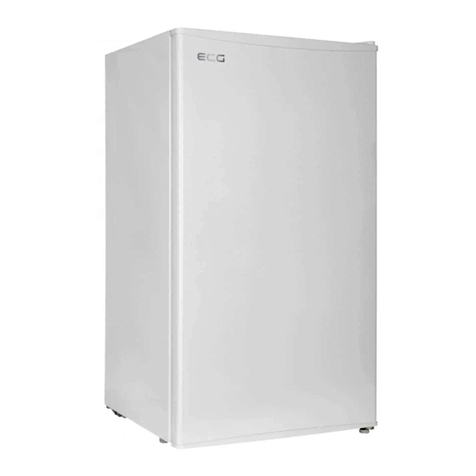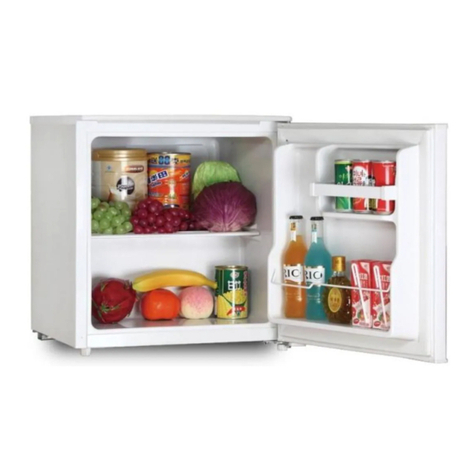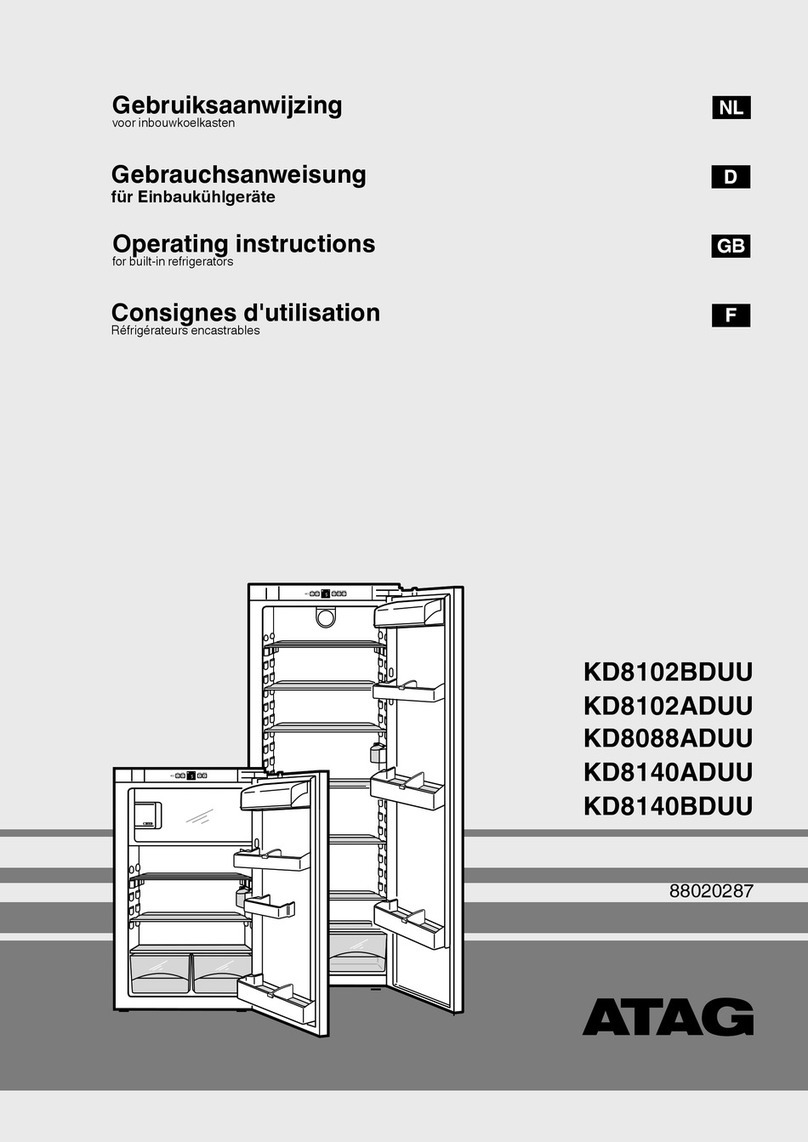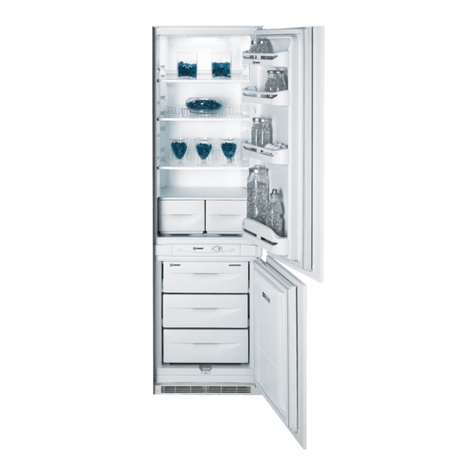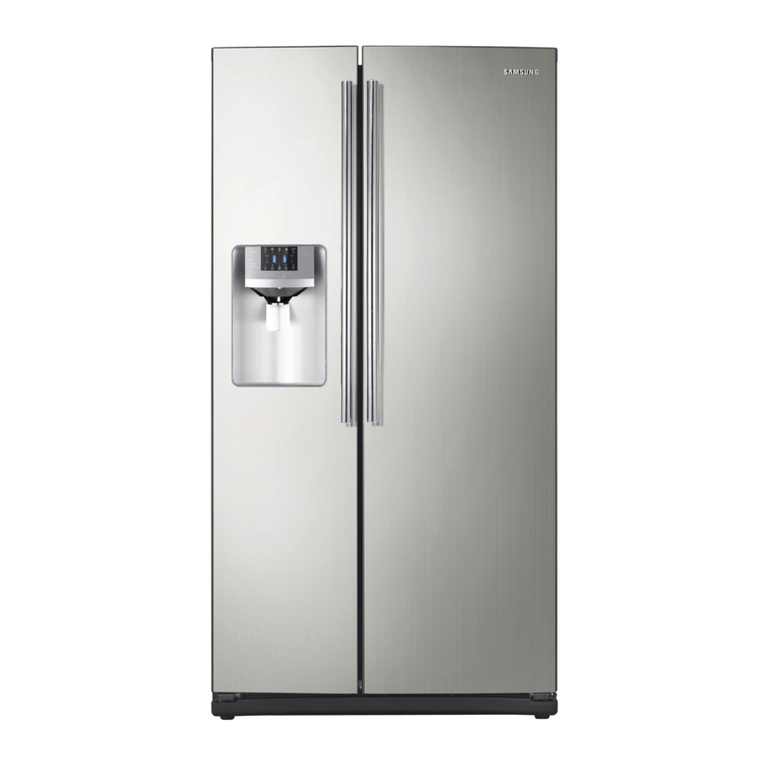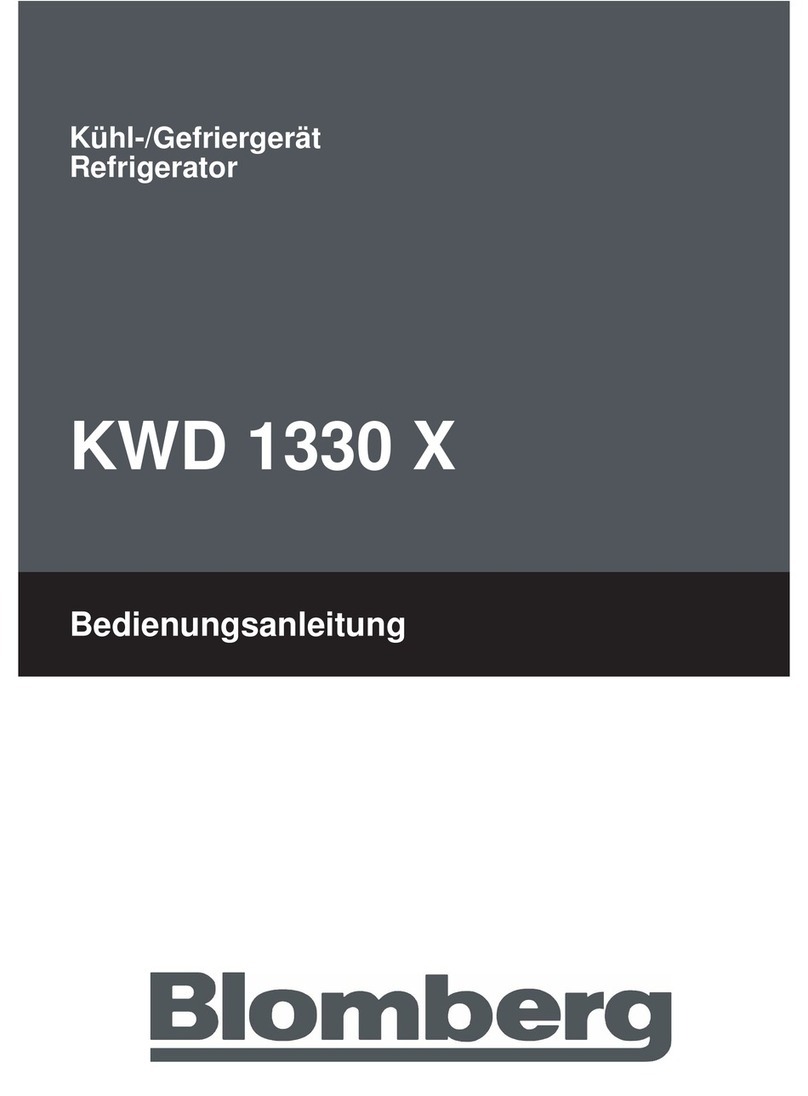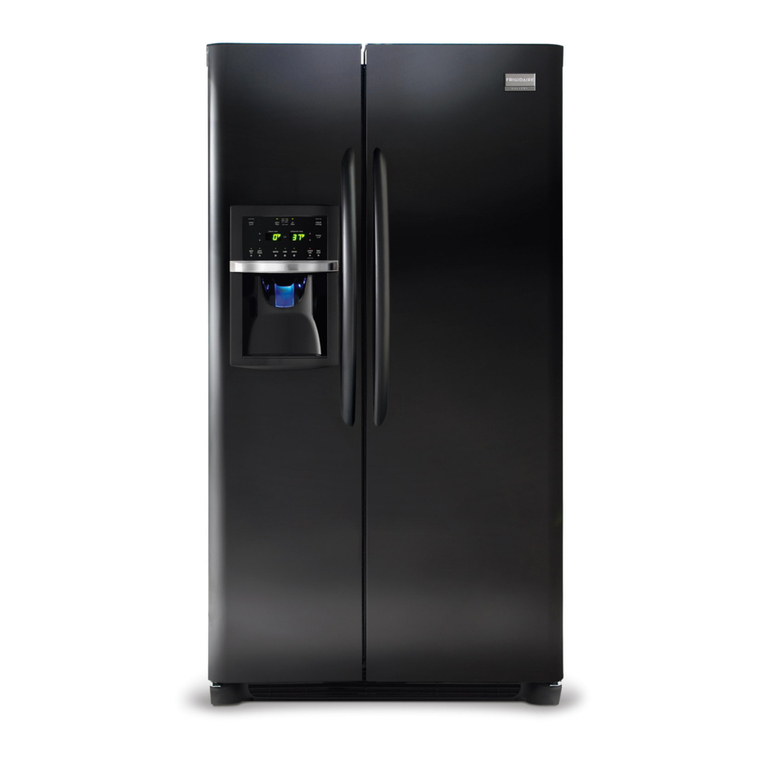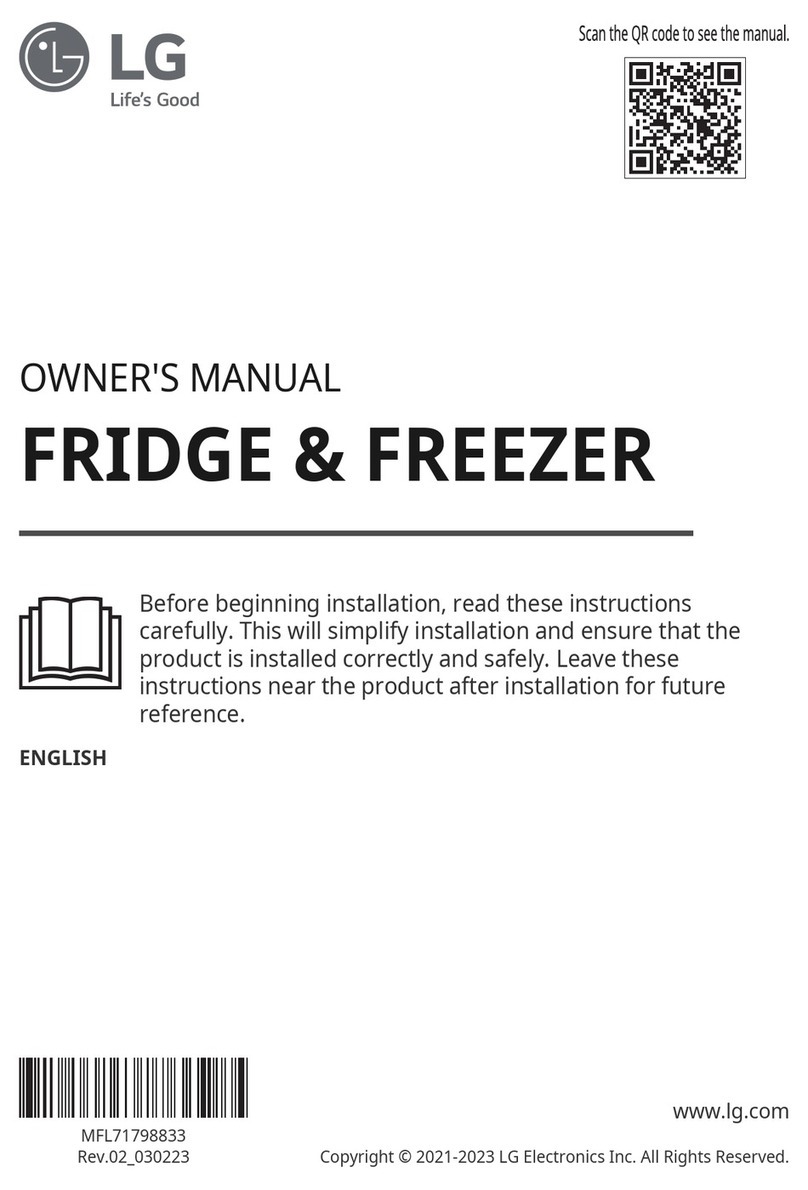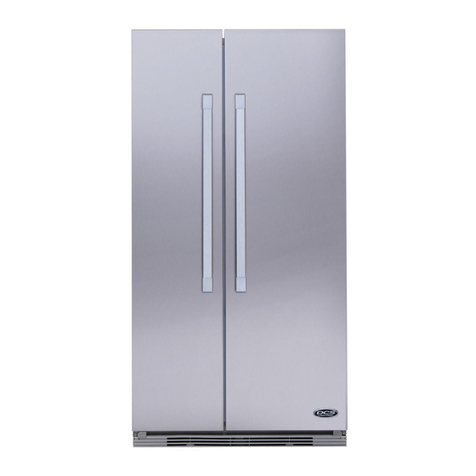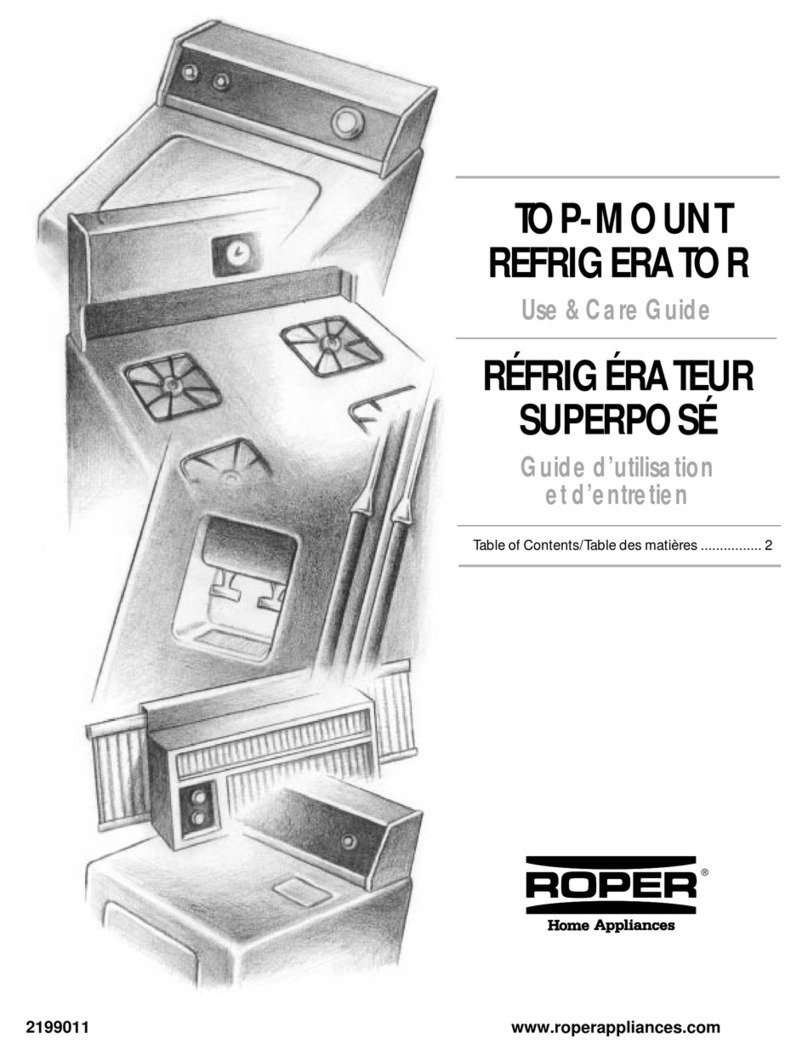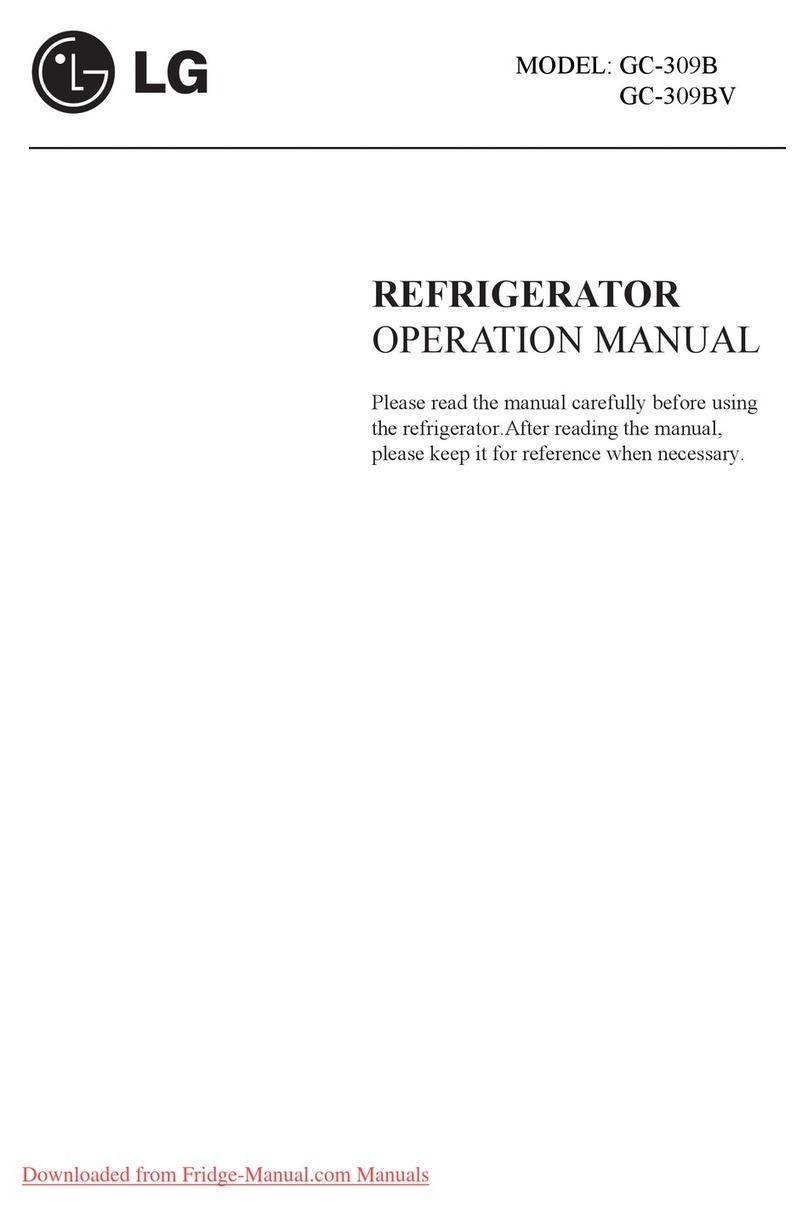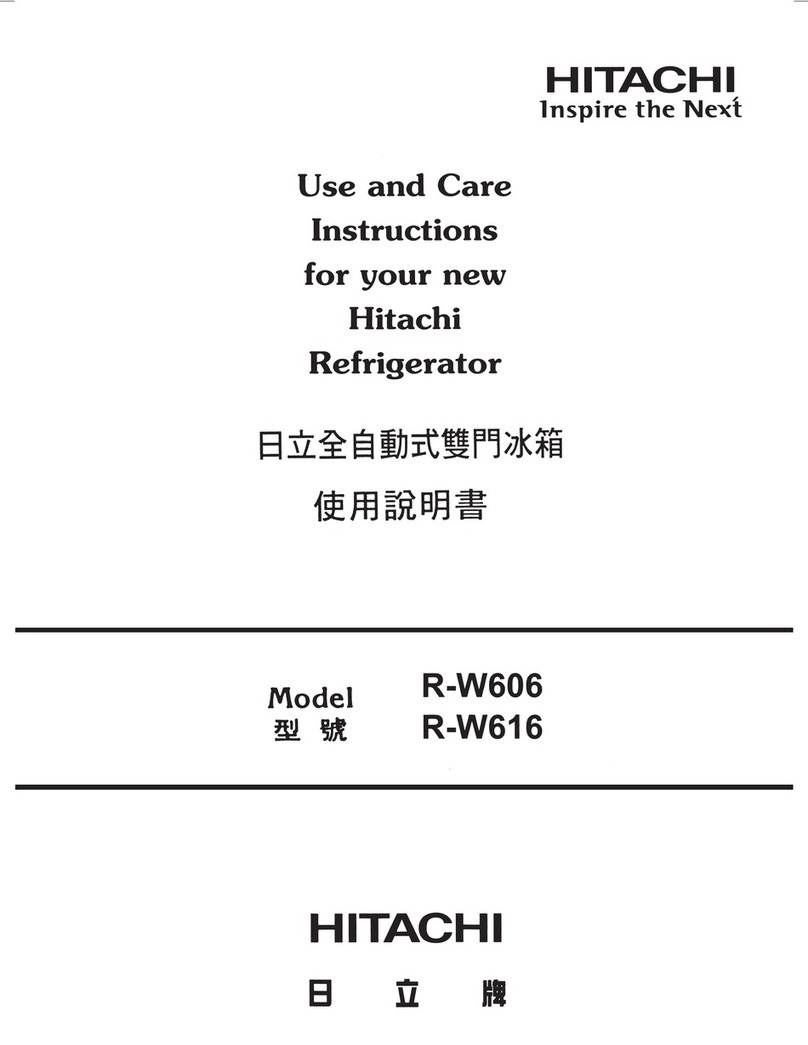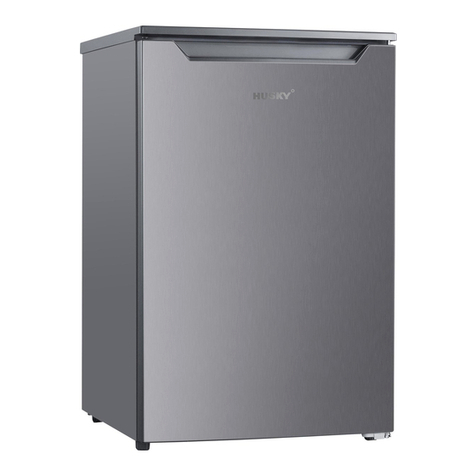ECG ERD 21444 WA++ User manual

ERD 21444 WA++
ERD 21430 W
English
Deutsch
Čeština
Hrvatski
Bosanski
Slovenčina
Always read the safety&use instructions carefully before using your appliance for the rst time. The user´smanual must be always included. Bitte lesen Sie vor der Inbetriebnahme des Produktes diese Anleitung
und die darin enthaltenen Sicherheitshinweise aufmerksam durch. Die Bedienungsanleitung muss dem Gerät immer beigelegt sein. Před uvedením výrobku do provozu si důkladně pročtěte tento návod
abezpečnostní pokyny, které jsou vtomto návodu obsaženy. Návod musí být vždy přiložen kpřístroji. Uvijek pročitajte sigurnosne upute iupute za uporabu prije prvog korištenja vašeg uređaja. Upute moraju uvijek
biti priložene. Pred uvedením výrobku do prevádzky si dôkladne prečítajte tento návod abezpečnostné pokyny, ktoré sú vtomto návode obsiahnuté. Návod musí byť vždy priložený kprístroju.
REFRIGERATOR
INSTRUCTION MANUAL
HLADNJAK
UPUTE ZA UPORABU
KÜHLSCHRANK
BEDIENUNGSANLEITUNG
CHLADNIČKA
NÁVOD NA OBSLUHU
CHLADNIČKA
NÁVOD KOBSLUZE


English
English
3
RefRigeRatoR
SAFETY INSTRUCTIONS
Read carefully and keep for future use!
Warning: The safety measures and instructions contained in this
manual do not include all conditions and potential situations. The user
must be aware that common sense, caution, and care are factors that
cannot be integrated into aproduct. These factors must be ensured by
the user(s) using and operating this equipment. We are not liable for
damages caused during shipping, by incorrect use, voltage uctuation
or the modication or adjustment of any part of the appliance.
To protect against arisk of re or electric shock, basic precautions shall
be taken while using electrical appliances, including the following:
1. Make sure the voltage in your outlet corresponds to the voltage
provided on the appliance label and that the socket is correctly
grounded. The outlet must be installed in accordance with
applicable electrical codes according to EN.
2. Do not operate the device if the cord is damaged. All repairs or
adjustments including cord replacements must be carried out
by aprofessional service centre! Do not remove the protective
covers from the appliance; there is arisk of electric shock!
3. The appliance must not come into direct contact with water or
other liquids in order to prevent apotential electric shock. Do not
immerse the cord or the plug in water!
4. Do not use the appliance in places, where agas leak or acontact
with an explosive atmosphere could occur. Do not touch the cord
or the device with wet hands. There is arisk of electric shock.
5. The power cord must remain accessible once the device
is installed. Do not shorten the cable or use adapters in
electrical outlets. Do not allow the cord to touch hot
surfaces or place the cord over sharp edges.
6. Do not turn the appliance on or o by plugging or
unplugging the power cord. Do not remove the power
cord from the outlet by yanking the cord. Unplug the
cable from the outlet by grasping the plug.
Refrigerator
English

English
English
4
7. Do not insert any objects into the device or place any objects on the
device (e.g. vases, cups, etc.). Never cover the ventilation openings!
8. Do not use in the appliance other electrical devices and refrigeration
equipment.
9. If this appliance is replacing an old product equipped with alock,
destroy the lock of the old appliance, so that children would not
lock themselves in (e.g. during aplay).
10.Do not use mechanical devices or other articial
means to speed up defrosting. Do not use electrical
appliances in the space designed to store foods.
Protect the cooling circuit of the appliance against
damage.
11.Do not allow children to play with the appliance. Also,
they may not sit on the shelves and hang on the door
of the appliance.
12.Do not use sharp metal objects to remove the ice
from the refrigerator, because they may damage the
refrigerating circuits and cause irreparable damage
to the appliance. If necessary, use aplastic scraper.
13.Do not store explosive substances in the appliance, e.g. sprays with
propellant gas.
14.Do not place containers with liquids (glass jars or tin cans) in the
freezer. The container could burst.
15.When you store bottles containing liquids with high content of
alcohol, they must be properly closed and in vertical position.
16.Do not expose the appliance to direct sunlight, do not use it outside
and do not expose it to rain.
17.Do not touch the cooling surfaces with wet hands. Risk of injury.
18.Do not eat the ice removed from the freezer.
19.This appliance is intended for household use and similar areas, such
as:
– kitchenettes in shops, oces, and other workplaces
– appliances used in the agricultural industry
– by guests in hotels, motels, and other residential areas

English
English
5
– in bed and breakfast establishments
20.This appliance may be used by children under 8 years of age
and older and persons with reduced physical, sensory or mental
capabilities or lack of experience and knowledge if supervised or
instructed to use the appliance in asafe manner and understand
the potential hazards. Children may not play with the appliance.
Cleaning and maintenance operations performed by the user shall
not be carried out by children without supervision.
21.Children aged 3 to 8 years can insert and remove food from
refrigerating appliances.
22.Child supervision is essential to prevent them from playing with the
appliance.
23.The manufacturer is not liable for any damage caused by improper
grounding/use.
To prevent food contamination, please follow these recommendations:
– Opening the door for along time can cause asignicant increase
in the temperature inside the appliance.
– Regularly clean surfaces and accessible drainage systems that
may come into contact with food.
– Clean water containers if not used for 48 h; ush the water system
connected to the water supply if the water has not owed for
5days.
– Store raw meat and sh in the refrigerator in suitable containers
so that they do not come into contact with or drip into other
foodstus.
– Two-star freezing compartments are suitable for storing pre-
frozen food, storing or making ice cream and making ice cubes.
– One-, two- and three-star compartments are not suitable for
freezing fresh food.
– If the refrigerating appliance is left empty for along time, turn it
o, defrost, clean, dry and leave the door open to prevent mold
formation inside the appliance.

English
English
6
RISK OF FIRE!
Warning: Risk of re/Flammable materials
This appliance contains R600a (the coolant isobutane), natural
gas which is very environmentally friendly but ammable. When
transporting and installing the equipment it is necessary to make sure
that no part of the cooling circuit is damaged. In the case of damage,
reduce the ame and ventilate the premises where the appliance is
located for afew minutes.
When replacing the refrigerator interior lighting, always unplug
the refrigerator. – otherwise there is a risk of electric shock. • If the
replacement of the interior lighting is too complicated for you, contact
your service representative. • If the products are equipped with LEDs,
do not remove the lighting cover and LED yourself. – contact your
service representatives.
REPLACING THE LED BULB
Do not remove the indicator cover or indicator yourself when the
internal or external LEDs no longer operate. Contact the service
representatives.

English
English
7
DESCRIPTION
This description only applies
to information regarding the
components for the appliance.
Individual parts may dier according
to the particular appliance model.
A) Freezer
B) Refrigerator
1. Freezer shelves
2. Refrigerator shelves
3. Drawer for storing fresh fruit and
vegetables
4. Adjustable feet
5. Door compartment for bottles
6. Door compartment
7. Thermostat
The image is for illustration only.
INSTALLATION AND TURNING ON THE APPLIANCE
• You can contact the service technicians to install and turn on the device properly.
• Before connecting the electricity, make sure that the voltage stated on the label corresponds to the
voltage in the socket / voltage for the electricity system in the building.
• The outlet must be accessible after installing the appliance.
Installing the device
• Place the refrigerator away from any sources of heat and in awell-ventilated position.
The refrigerator should be located aminimum of 50 cm away from radiators, gas stoves
and other heat sources, and 5 cm away from electric stoves.
• Leave free space of minimum 15 cm above the appliance.
• Connect the plastic spacer to the condenser on the rear wall of the refrigerator to
prevent the refrigerator from leaning against the wall and thereby reduce its power.
• Do not place heavy items on the refrigerator.
• If the appliance is installed beside another refrigerator or freezer, keep a minimum
distance of 2 cm to prevent vapour condensation.
• The refrigerator must stand rmly in ahorizontal position. Use the two adjustable front feet for levelling.
1
7
2
3
4
6
5
A
B

English
English
8
TRANSPORT AND RELOCATION
Transport and relocation
• Store the original packaging and foam polystyrene (PS) if they are needed.
• When transporting the appliance, secure with awide strap or strong rope and follow the instructions on
the package.
• Before transport or relocation secure or remove all movable items (i.e. shelves, drawer for fresh fruit and
vegetables….).
Before switching on
• Leave the product to rest for at least 3 hours from the time it was transported to your home.
• You may detect aslight odour when you rst switch it on. This odour will disappear once
the appliance starts to cool.
VARIOUS FUNCTIONS AND OPTIONS
Setting of the thermostat
The freezer and refrigerator thermostat automatically regulates the internal temperature. You can set lower
temperature by turning the knob from position 1to 5.
Setting the freezer and refrigerator thermostat
OFF/0: O
MIN/1-2: For short-term storage of food in the freezer (knob from minimum to medium).
MED/3-4: For long-term storage of food in afreezer (knob to medium value).
MAX/5: To freeze fresh foods. After reaching the cold state, it is necessary to set the knob to the previous
position.
Turn on the appliance
• On rst switch-on, the appliance should be operated continuously for at least 24 hours until it has cooled
to asucient temperature.
• During this time do not open the door too often. Fill the appliance with foods.
• If you turn o or unplug the appliance, wait at least 5 minutes before restarting or turning it on to avoid
damage to the compressor.

English
English
9
• Your refrigerator is designed to operate at the ambient temperature specied in standards according to
the climatic class indicated on the rating plate. We do not recommend operating the refrigerator in an
environment that is not within the stated range due to eect on its eciency.
Climatic classes Surrounding
T16 up to 43°C
ST 16 up to 38°C
N16 up to 32°C
SN 10 up to 32°C
STORING FOOD
Cooling compartment
• To reduce humidity and consequent increase the frost, never put liquids in unsealed containers into the
refrigerator. Frost tends to concentrate in the coldest parts of the evaporator. Storing uncovered liquids
results in amore frequent need for defrosting.
• Never put warm foods in the refrigerator. These should cool down at room temperature and then be
placed in the refrigerator to ensure adequate air circulation.
• Foods or food containers should not touch the back wall of the refrigerator because they could freeze to
the wall. Do not keep regularly opening the door of the refrigerator.
• Meat and clean sh (packed in apackage or plastic foil) can be placed in the refrigerator, which can be
used in 1–2 days.
• Fruit and vegetables without packaging can be placed in the part designated for fresh fruit and vegetables.
Freezer compartment
• The freezer is designated for the storage of food frozen at very low temperature, long-term storage of
frozen food, and for the production of ice.
• Only use the shelves in the door of the freezer to store frozen food, not for storing hot food designated
for freezing.
• Do not put fresh and frozen food next to each other. The frozen food may thaw.
• When freezing fresh food (such as meat, sh or chopped meat), cut them into parts that can be used at
the same time.
• Storing frozen food: instructions are usually stated on the packages, which must be followed. If there is
no information on the packaging, food should not be stored for longer than three months from the date
of purchase.
• When purchasing frozen food, make sure that it was frozen at a suitable temperature and that the
packaging is not damaged.
• Frozen food should be kept in suitable packages to retain the quality and should be returned to the freezer
compartment as soon as possible.
• If apackage of frozen food shows moisture or abnormal bulging, it is probable that it was stored at the
wrong temperature and the content is spoiled.
• The storage period for frozen food depends on the room temperature, the thermostat setting, the
frequency of opening the door of the freezer, the type of food and the time of transporting the product
from the shop to the household. Always follow the instructions printed on the packaging and never
exceed the maximum storage time stated on the package.

English
English
10
CLEANING AND MAINTENANCE
• Before cleaning, disconnect the appliance from the electricity socket.
• Do not clean the appliance with water.
• The refrigerator and the freezer should be periodically cleaned using alukewarm
water solution and edible soda.
• Clean accessories separately using soapy water. Do not use awashing machine.
• Do not use abrasive products, detergents, and soaps. After
washing, rinse with clean water and dry thoroughly. After cleaning,
use dry hands to plug the appliance into the electricity socket.
• Clean the condenser (the back part of the appliance) using abrush
aminimum of once ayear. This will increase productivity and save
energy.
Recommendation
If you are not using the appliance for along time (for example during
summer holidays), disconnect the refrigerator from the power supply,
clean it and leave the door open. This will prevent the origination of
mould and odour.
Defrosting the refrigerator
• Defrosting occurs automatically during operation in part of the refrigerator; water ows into the
evaporation channel and is automatically evaporated.
• The evaporator channel and the hole for collecting water (in the rear part of the shelf for fresh foods)
should be periodically cleaned. This will prevent the accumulation of water in the lower part.
Freezer defrosting
• Frost build-up in afreezer must be periodically removed at least twice ayear.
• Do not use sharp metal objects to remove the frost build-up. They can break acircuit and cause irreparable
damage to the appliance. Use aplastic scraper.
• Defrosting should be carried out when the frost on the shelves becomes thicker than 5 mm.
• The day before defrosting set the thermostat to the MAX/5 position to freeze the food completely.
• During defrosting, the frozen food should be packed into several layers of paper and stored in acold place.
This will keep the temperature of your food low for along time.

English
English
11
• Set the thermostat to the position OFF/0, disconnect the appliance from the power supply and leave the
door open until the defrosting is complete.
• To speed up the defrosting process, place one or more containers with hot water in the freezer.
• Carefully dry the inside of the appliance with aclean cloth or sponge.
• When the defrosting is complete, put the food back into the freezer, set the thermostat to the max.
position, and keep in mind that it is necessary to consume the food within short time.
Replacement of the bulb in the refrigerator
If the products are equipped with LEDs, do not remove the lighting cover and LED yourself. Contact the service
representatives.
1. Unplug the appliance from the power supply.
2. Press the hooks on the sides of the top of the cover and remove the bulb cover.
3. Replace the defective bulb with anew one with maximum power 15 W.
4. Install the bulb cover and connect the appliance to the power supply after 5 minutes.
Reversing the door opening
If you need to change the direction of opening the door, consult your service technician.
TROUBLESHOOTING
If the refrigerator does not work correctly, before calling aservice technician, check the appliance according
to the following instructions:
The refrigerator does not work
Check that:
• The electricity supply is not interrupted.
• The main switch for the electric current is not o.
• the thermostat is not set to OFF/0 position,
• The electricity socket is working. To check, plug another appliance that you know is working into the same
socket.
The performance of the refrigerator is low
Check that:
• there is not too much food placed in the appliance,
• is the thermostat set to position MIN/1 (if yes, set the thermostat to ahigher value)
• is the door properly closed,
• isn’t there dust on the condenser,
• is there is enough space around the rear and side walls to circulate the air.
The refrigerator is noisy
Cooling gas, which circulates in the refrigerator, may cause aslight noise (bubbling sound) even when the
compressor is not running. Do not worry, this is completely normal. If these sounds are dierent, make sure
that:
• the appliance is in the horizontal position,
• It is not in contact with the rear side.

English
English
12
• Parts of the appliance do not vibrate.
Water is in the lower part of the refrigerator
Check that:
• The water drain hole for the defrosting is not clogged (use adefrosting drain plug to drain water and clean
the hole).
TECHNICAL DATA
Specications for the refrigerator in the home according to EU regulations no. 1060/2010
Manufacturer ECG ECG
Model ERD 21444 WA++ ERD 21430 W
Type Combined free-standing Combined free-standing
Household refrigerating appliances category 7 7
Product Dimensions (H xW xD) 1440 × 540 × 570 mm 1435 × 550 × 550 mm
Product weight 39 kg 37 kg
Climate class ST/N ST/N
Energy class A++ A++
Energy consumption/annual 173 kWh/annual 170 kWh/annual
Total usable volume 213 l 204 l
Net volume of the refrigerator 171 l 164 l
Net volume of the freezer compartment 42 l 40 l
Noise level 42 dB (A) 40 dB (A)
Coolant R600a R600a
Building-in option no no
Voltage/Frequency 220–240 V~ / 50 Hz 220–240 V~/ 50 Hz
Freezer class **** ****
Freezer power 2 kg/24 h 2 kg/24 h
USE AND DISPOSAL OF WASTE
Wrapping paper and corrugated paperboard – deliver to scrapyard. Packing foil, PE bags, plastic elements – throw into plastic
recycling containers.
DISPOSAL OF PRODUCTS AT THE END OF LIFETIME
Disposal of electric and electronic equipment (valid in EU member countries and other European
countries with an implemented recycling system)
The represented symbol on the product or package means the product shall not be treated as domestic waste.
Hand over the product to the specied location for recycling electric and electronic equipment. Prevent negative
impacts on human health and the environment by properly recycling your product.
Recycling contributes to preserving natural resources. For more information on the recycling of this product,
refer to your local authority, domestic waste processing organization or store, where you purchased the product.
This product complies with EU directive requirements on electromagnetic compatibility and
electrical safety.
The instruction manual is available at website www.ecg-electro.eu.
Changes in text and technical parameters reserved.
Old refrigerators and freezers contain insulation gases and freezing media, which must be disposed o. Entrust
the disposal to acompetent local waste disposal service. In doubt contact your local authority or your vendor.
Make sure that the pipes of the cooling unit, which will be removed by the appropriate waste disposal,service
are not damaged.
08/05

Deutsch
Deutsch
13
KühlschranK
SICHERHEITSHINWEISE
Bitte aufmerksam lesen und für den künftigen Gebrauch gut
aufbewahren!
Warnung: Die in dieser Anleitung aufgeführten
Sicherheitsvorkehrungen und Hinweise umfassen nicht alle Umstände
und Situationen, zu denen es kommen könnte. Der Anwender muss
begreifen, dass der gesunde Menschenverstand, Vorsicht und Sorgfalt
zu Faktoren gehören, die sich in kein Produkt einbauen lassen. Diese
Faktoren müssen durch den Anwender bzw. mehrere Anwender bei
der Verwendung und Bedienung dieses Gerätes gewährleistet werden.
Wir haften nicht für Schäden, die durchTransport, eine unsachgemäße
Verwendung, Spannungsschwankungen sowie eine Änderung oder
Modikation des Gerätes entstehen.
Um Bränden oder Stromunfällen vorzubeugen, müssen bei
der Verwendung von elektrischen Geräten u.a. folgende
Vorsichtsmaßnahmen eingehalten werden:
1. Vergewissern Sie sich, dass die Spannung in Ihrer Steckdose mit der
Spannung auf dem Geräteschild übereinstimmt und die Steckdose
ordnungsgemäß geerdet wurde. Die Steckdose muss gemäß
gültiger elektrotechnischer Norm (EN) installiert werden.
2. Benutzen Sie das Gerät nicht, falls das Stromkabel beschädigt
ist. Lassen Sie sämtliche Reparaturen, Einstellungen und das
Auswechseln des Stromkabels durch einen autorisierten
Kundendienst vornehmen! Demontieren Sie niemals die
Schutzabdeckungen des Gerätes. Dies könnte zu einem
Stromunfall führen!
3. Schützen Sie das Gerät vor direktem Kontakt mit Wasser und
sonstigen Flüssigkeiten, um Stromunfällen vorzubeugen.
Stromkabel oder Stecker niemals ins Wasser tauchen!
4. Gerät niemals in einer feuchten Umgebung oder in Räumen
benutzen, in denen Gas entkommen könnte oder Kontakt mit einer
explosiven Atmosphäre droht. Stromkabel oder Gerät niemals mit
nassen Händen berühren. Es könnte zu einem Stromunfall kommen.
Kühlschrank
Deutsch

Deutsch
Deutsch
14
5. Der Netzstecker sollte auch nach der Installation des Gerätes leicht
erreichbar sein. Verkürzen Sie nicht das Kabel und
benutzen keine Mehrfachsteckdosen. Das Stromkabel
darf nicht mit heißen Teilen in Berührung kommen oder
über scharfe Kanten führen.
6. Gerät niemals durch das Einstecken/Herausziehen des Steckers ein-
oder ausschalten. Ziehen Sie nicht am Kabel, um den Stecker aus
der Steckdose zu ziehen. Ziehen Sie am Stecker, um das Kabel aus
der Steckdose zu ziehen.
7. Stecken Sie keine Gegenstände in die Geräteönungen
und stellen auf das Gerät keine Gegenstände (z.B. Vasen
oder Tassen). Belüftungsönungen niemals verdecken!
8. Benutzen Sie innerhalb des Verbrauchsgerätes keine
anderen Elektrogeräte oder Gefrieranlagen.
9. Falls dieses Verbrauchsgerät ein ausgedientes Gerät mit Schloss
ersetzen soll, entfernen Sie zunächst das Schloss an diesem Gerät.
Die Tür könnte sich versehentlich abschließen und
Kinder im Gefrierschrank einsperren (z.B. beim
Spielen).
10.Benutzen Sie weder mechanische Vorrichtungen
noch sonstige Hilfsmittel, um das Abtauen zu
beschleunigen. Benutzen Sie keine Elektrogeräte im
Bereich, in dem Lebensmittel aufbewahrt werden.
Schützen Sie den Kühlkreislauf vor Beschädigungen.
11.Kinder dürfen nicht mit dem Gerät spielen. Weiter
dürfen sie nicht auf Regalen sitzen oder sich an die
Tür des Verbrauchers hängen.
12.Benutzen Sie zum Entfernen von Eis keine scharfen
Metallgegenstände, da diese den Kühlkreislauf
beschädigen und zu irreparablen Schäden führen könnten. Falls
nötig, benutzen Sie eine Kunststospatel.
13.Lagern Sie im Verbraucher keine Sprengstoe wie z.B. Sprühdosen
mit Treibgas.

Deutsch
Deutsch
15
14.Sie sollten im Gefrierteil keine Verpackungen (Glasaschen oder
Konserven) mit Flüssigkeiten aufbewahren. Das Gefäß könnte
zerspringen.
15.Flaschen mit Flüssigkeiten mit einem hohen Alkoholgehalt müssen
gut verschlossen und vertikal gelagert werden.
16.Setzen Sie das Gerät weder Sonnenlicht noch Regen aus. Benutzen
Sie das Gerät nicht im Freien.
17.Berühren Sie nicht die Kühlächen, vor allem nicht mit nassen
Händen. Mögliche Verletzung.
18.Verzehren Sie nicht das Eis, das aus dem Gefrierteil entfernt wurde.
19.Dieses Gerät ist für die Anwendung im Haushalt und in
vergleichbaren Räumlichkeiten bestimmt:
– Küchenzeilen in Geschäften, Büros und an sonstigen
Arbeitsplätzen
– Geräte in der Landwirtschaft
– Verbrauchsgeräte, die Gästen in Hotels, Motels und ähnlichen
Beherbergungseinrichtungen zur Verfügung stehen
– Verbrauchsgeräte in Betrieben mit Übernachtung und Frühstück
20.Kinder im Alter von 8 Jahren und älter sowie Personen mit
verminderten physischen, sensorischen und mentalen Fähigkeiten
sowie mangelnden Erfahrungen und Kenntnissen, dürfen dieses
Gerät nur unter Aufsicht benutzen, oder nachdem diese über einen
gefahrlosen Gebrauch belehrt wurden und mögliche Gefahren
verstehen. Kinder dürfen nicht mit dem Gerät spielen. Reinigungs-
und Wartungsarbeiten dürfen auch Kinder vornehmen, es sei denn,
sie werden beaufsichtigt.
21.Kinder von 3 bis 8 Jahren können Lebensmittel in Kühlgeräte geben
und herausnehmen.
22.Kinder sollten beaufsichtigt werden, damit sichergestellt wird, dass
sie mit dem Gerät nicht spielen.
23.Der Hersteller haftet nicht für Schäden infolge einer falschen
Erdung/Anwendung.
Um eine Kontamination der Lebensmittel zu vermeiden, sollten
folgende Hinweise befolgt werden:

Deutsch
Deutsch
16
– Durch das lange Önen der Tür könnte sich die Temperatur im
Innenbereich des Verbrauchers erheblich erhöhen.
– Reinigen Sie regelmäßig Oberächen, die in Kontakt
mit Lebensmitteln kommen könnten, und zugängliche
Ableitungssysteme.
– Wasserbehälter, die bis zu 48 Stunden nicht benutzt wurden,
sollten gereinigt werden. Falls Wasser für bis zu 5 Tagen nicht
durchgeossenist,solltedasandieWasserzufuhrangeschlossenes
Wassersystem durchgespült werden.
– Rohes Fleisch und Fisch sollten im Verbraucher in geeigneten
Verpackungen gegeben werden, damit diese nicht in Kontakt mit
anderen Lebensmittel kommen oder auf diese abtropfen.
– Zwei-Sterne-Gefrierbereiche sind vor allem zur Lagerung von
vorgekühlten Lebensmitteln und zur Lagerung oder Herstellung
von Eis und Eiswürfeln geeignet.
– Ein-, Zwei- oder Drei-Sterne-Bereiche sind nicht zum Tiefkühlen
von frischen Lebensmitteln geeignet.
– Sollte das Kühlgerät für längere Zeit leerstehen, ausschalten,
abtauen, reinigen, trocknen und oen stehen lassen, um der
Entstehung von Schimmel im Innenbereich vorzubeugen.
BRANDGEFAHR!
Warnung: Brandgefahr / brennbare Stoe
Dieses Gerät enthält R600a (Kühlmedium Isobutan) und Erdgas,
das zwar umweltfreundlich, aber brennbar ist. Beim Transport und
der Installation muss beachtet werden, damit kein Abschnitt des
Kühlkreislaufes beschädigt wird. Wurde der Kühlkreislauf beschädigt,
beugen Sie einem Brand vor und sorgen dafür, dass die Räume, in
denen sich das Gerät bendet, minutenlang belüftet werden.
Kühlschrank vor dem Auswechseln der Innenbeleuchtung vom
Strom trennen. – Es besteht die Gefahr eines Stromunfalls. • Sollte

Deutsch
Deutsch
17
das Auswechseln der Innenbeleuchtung für Sie zu kompliziert sein,
Wenden Sie sich an Ihren Ansprechpartner im Kundenservice. •Wurden
die Produkte mit LED-Dioden ausgestattet, sollten diese oder deren
Gehäuse niemals vom Kunden selbst demontiert werden. – Wenden
Sie sich an Ihren Ansprechpartner im Kundenservice.
AUSWECHSELN DER LEDBELEUCHTUNG
Wenn die inneren oder äußeren LED-Lichter nicht mehr funktionieren,
sollten diese oder deren Gehäuse niemals vom Kunden selbst
demontiert werden. Wenden Sie sich an Ihren Ansprechpartner im
Kundenservice.
BESCHREIBUNG
Diese Beschreibung informiert über
einzelne Geräteteile.
Einzelne Teile können in
Abhängigkeit vom jeweiligen
Gerätemodell variieren.
A) Gefrierschrank
B) Kühlschrank
1. Gefrierschrankregal
2. Kühlschrankregal
3. Fach für frisches Gemüse und
Obst
4. Verstellbare Füße
5. Abstellfach für Flaschen
6. Türfach
7. Thermostat
Das Bild dient nur zur
Veranschaulichung.
1
7
2
3
4
6
5
A
B

Deutsch
Deutsch
18
INSTALLATION UND EINSCHALTEN DES GERÄTES
• Für eine richtige Installation und das Einschalten des Gerätes können Wartungstechniker kontaktiert
werden.
• Sie sollten sich vor dem Anschließen an das Strom vergewissern, dass die auf dem Geräteschild angeführte
Spannung mit der Spannung in der Steckdose / im Gebäudenetz übereinstimmt.
• Die Steckdose muss nach dem Aufstellen des Kühlschrankes weiterhin gut erreichbar sein.
Aufstellung
• Platzieren Sie den Kühlschrank in ausreichender Entfernung von Wärmequellen und in
einer gut belüfteten Position. Der Kühlschrank muss mindestens 50 cm von Radiatoren,
Gasherden und sonstigen Wärmequellen und 5 cm von Elektroherden platziert werden.
• Über dem Gerät ist ein Mindestabstand von 15 cm zu gewährleisten.
• Befestigen Sie an den Kondensator auf der Rückseite des Kühlschranks ein
Distanzelement, damit der Kühlschrank nicht die Wand berührt, was die Kühlleistung
beeinträchtigen könnte.
• Stellen Sie keine schweren Gegenstände auf das Gerät.
• Beabsichtigten Sie das Gerät neben einen anderen Kühl- oder Gefrierschrank zu installieren, sollten Sie
einen Mindestabstand von 2cm einhalten, um eine Dampfkondensation zu vermeiden.
• Das Gerät muss stabil und waagerecht stehen. Benutzen Sie zum Ausgleichen die zwei Vorderfüße.
TRANSPORT UND UMSTELLUNG
Transport und Umstellung
• Die ursprüngliche Verpackung und das Schaumpolystyrol (PS) sollten aufbewahrt werden.
• Benutzen Sie beim Transport ein breites Sicherungsband oder ein starkes Seil und befolgen die auf der
Verpackung angeführten Anweisungen.
• Vor dem Transport oder der Umstellung sollten sämtliche beweglichen Gegenstände gesichert oder
herausgenommen werden (Regale, Fach für frisches Gemüse und Obst u. dgl.).
Vor dem Einschalten
• Nachdem das Produkt zu Hause aufgestellt wurde, sollte es mindestens 3 Stunden
stillstehen.
• Nach dem ersten Einschalten kann ein leichter Geruch abgegeben werden. Dieser
verschwindet sobald der Kühlschrank zu kühlen beginnt.

Deutsch
Deutsch
19
FUNKTIONEN UND OPTIONEN
Thermostateinstellung
Der Thermostat des Kühl- und Gefrierschrankes reguliert automatisch die Innentemperatur. Durch Drehen des
Drehknopfes von 1auf 5kann eine niedrigere Temperatur eingestellt werden.
Einstellung des Kühlschrank- und Gefrierschrankthermostats
OFF/0: Aus
MIN/1-2: Für kurzzeitige Aufbewahrung von Lebensmitteln im Gefrierteil (minimaler bis mittlerer Wert).
MED/3-4: Für langfristige Aufbewahrung von Lebensmitteln im Gefrierteil (mittlerer Wert).
MAX/5: Zum Tiefkühlen von frischen Lebensmitteln. Für mehr Kühlleistung sollte der Drehknopf ein
Schritt zurück versetzt werden.
Einschalten des Gerätes
• Beim ersten Einschalten sollte das Gerät ohne Unterbrechung mindestens 24 Stunden arbeiten, bis eine
ausreichende Temperatur erreicht wird.
• Während dieser Zeit sollten Sie nicht allzu oft die Kühlschranktür önen. Geben Sie Lebensmittel in den
Kühlschrank.
• Wurde der Kühlschrank ausgeschaltet oder vom Stromnetz getrennt, sollten Sie vor dem Neustart oder
einem erneuten Einschalten mindestens 5 Minuten warten, damit der Kompressor nicht beschädigt wird.
• Ihr Kühlschrank ist für den Betrieb in einer Umgebungstemperatur geeignet, die der jeweiligen
Klimaklasse entspricht und dem Geräteschild zu entnehmen ist. Wir empfehlen nicht den Kühlschrank
in einer Umgebung zu benutzen, die außerhalb der angeführten Werte liegt. Diese Anwendungsweise
reduziert die Kühlleistung.
Klimaklassen Umgebung
T16 bis 43°C
ST 16 bis 38°C
N16 bis 32°C
SN 10 bis 32°C
AUFBEWAHRUNG VON LEBENSMITTELN
Kühlteil
• Damit Feuchtigkeit und die anschießende Eisbildung reduziert wird, sollten im Kühlschrank keine
Flüssigkeiten in nicht abgedichteten Verpackungen gelagert werden. Die Vereisung könnte sich an den
kältesten Teilen des Verdampfers ansammeln. Falls nicht abgedichtete Flüssigkeiten in den Kühlschrank
gegeben werden, könnte dies eine Ursache für ein häugeres Abtauen sein.
• Geben Sie niemals warme Lebensmitteln in den Kühlschrank. Warme Lebensmittel sollten zunächst bei
Zimmertemperatur abkühlen und erst dann in den Kühlschrank gegeben werden, und zwar so, damit die
Luftzirkulation nicht beeinträchtigt wird.
• Lebensmittel oder Verpackungen von Lebensmitteln sollten nicht die Rückwand des Kühlschranks
berühren, da diese anfrieren könnten. Die Tür sollten nicht zu oft geönet werden.

Deutsch
Deutsch
20
• In den Kühlschrank kann Fleisch oder gesäuberter Fisch gegeben werden (und zwar inVerpackungen oder
einer Plastikfolie), die binnen 1–2 Tagen verzehrt werden.
• Obst und Gemüse kann in dem Teil gelagert werden, der für frisches unverpacktes Obst und Gemüse
bestimmt ist.
Gefrierteil
• Der Gefrierteil dient zur Lagerung von tiefgekühlten Lebensmitteln, zur Aufbewahrung von langfristig
tiefgefrorenen Lebensmitteln und zur Herstellung von Eiswürfeln.
• Die Regale in den Türen dienen ausschließlich zur Aufbewahrung von tiefgekühlten Lebensmitteln und
keineswegs zur Aufbewahrung von warmen Lebensmitteln, die tiefgekühlt werden sollen.
• Frische und tiefgekühlte Lebensmittel gehören nicht nebeneinander. Tiefgekühlte Lebensmittel könnten
auftauen.
• Frische Lebensmittel (Fleisch, Fische oder Hackeisch), sollten vor dem Tiefkühlen in Portionen aufgeteilt
werden.
• Lagerung von tiefgekühlten Lebensmitteln: den Verpackungen sind Anweisungen zu entnehmen, die
unbedingt eingehalten werden sollten. Falls keine Informationen auf der Verpackung angeführt sind,
sollten die Lebensmittel innerhalb von 3 Monaten verzehrt werden.
• Sie sollten sich beim Kauf von tiefgekühlten Nahrungsmitteln vergewissern, dass diese bei einer
ausreichenden Temperatur eingefroren wurden. Kontrollieren Sie die Verpackung auf mögliche
Beschädigung.
• Tiefgekühlte Lebensmittel sollten in geeigneten Verpackung transportiert werden, damit deren Qualität
bewahrt wird. Darüber hinaus sollten diese möglichst schnell wieder eingefroren werden.
• Sollte dieVerpackung des jeweiligen Lebensmitteln Anzeichen von Feuchtigkeit haben oder ungewöhnlich
ausgebeult sein, ist höchstwahrscheinlich, dass die Lebensmittel bei einer ungeeigneten Temperatur
aufbewahrt wurden und der Inhalt verdorben ist.
• Die Lagerungszeit von tiefgekühlten Lebensmitteln hängt von der Zimmertemperatur, der Einstellung
des Thermostaten, der Frequenz des Türönens, dem Lebensmitteltyp und der Zeit ab, die zum Transport
aus dem Regal in den Haushalt benötigt wurde. Sie sollten stets die auf der Verpackung angeführten
Anweisungen einhalten und niemals die maximale Lagerungszeit überschreiten.
REINIGUNG UND INSTANDHALTUNG
• Das Gerät muss vor der Reinigung vom Stromnetz getrennt werden.
• Reinigen Sie das Gerät nicht so, indem Sie Wasser einlassen.
• Der Kühl- und Gefrierteil sollten periodisch gereinigt werden, und zwar mit
lauwarmem Wasser und Speisesoda.
• Reinigen Sie das Zubehör separat mit Seifenwasser. Benutzen Sie keine
Geschirrspülmaschine.
• Benutzen Sie keine abrasiven Produkte, Reinigungsmittel oder
Seifen. Spülen Sie einzelne Teile nach dem Waschen mit klarem
Wasser aus und lassen gut trocknen. Gerät nach der Reinigung
erneut an das Stromnetz anschließen. Achten Sie darauf, dass Ihre
Hände trocken sind.
• Der Kondensator (auf der Rückseite) sollte mindestens einmal pro
Jahr mit einem Besen abgekehrt werden. Somit erhöhen Sie die
Geräteleistung und sparen Stromkosten.
This manual suits for next models
1
Table of contents
Languages:
Other ECG Refrigerator manuals
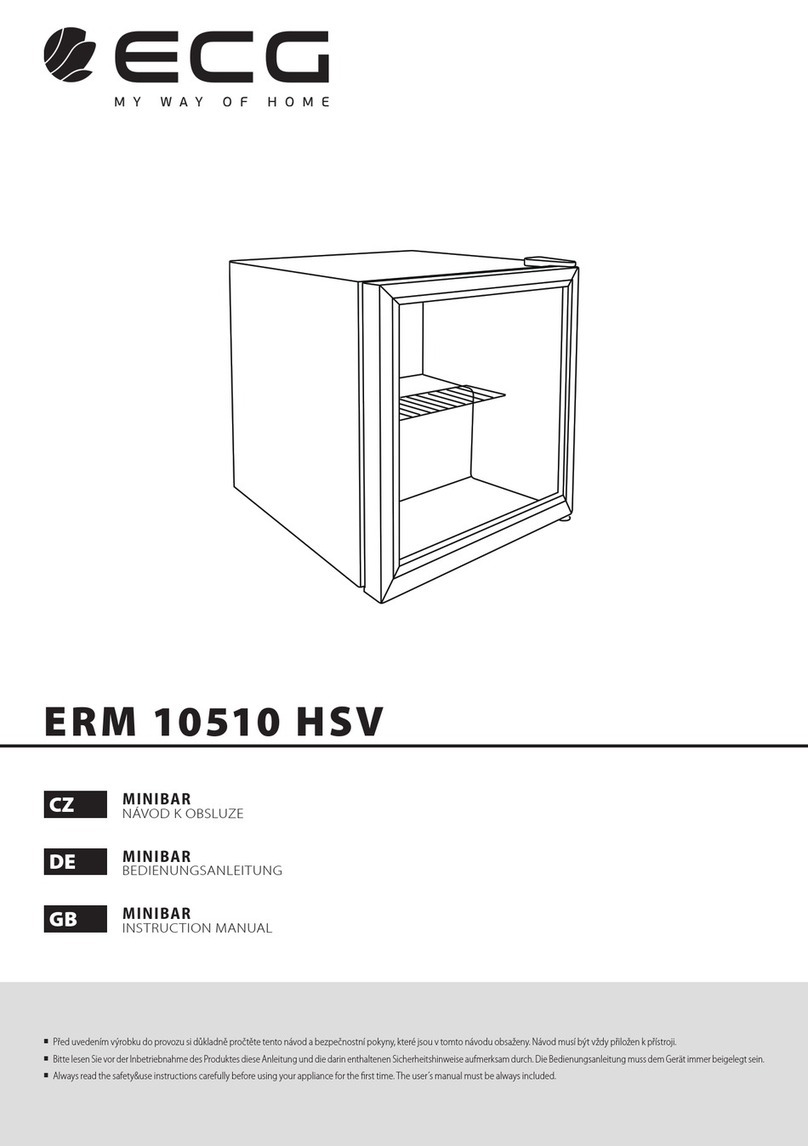
ECG
ECG ERM 10510 HSV User manual
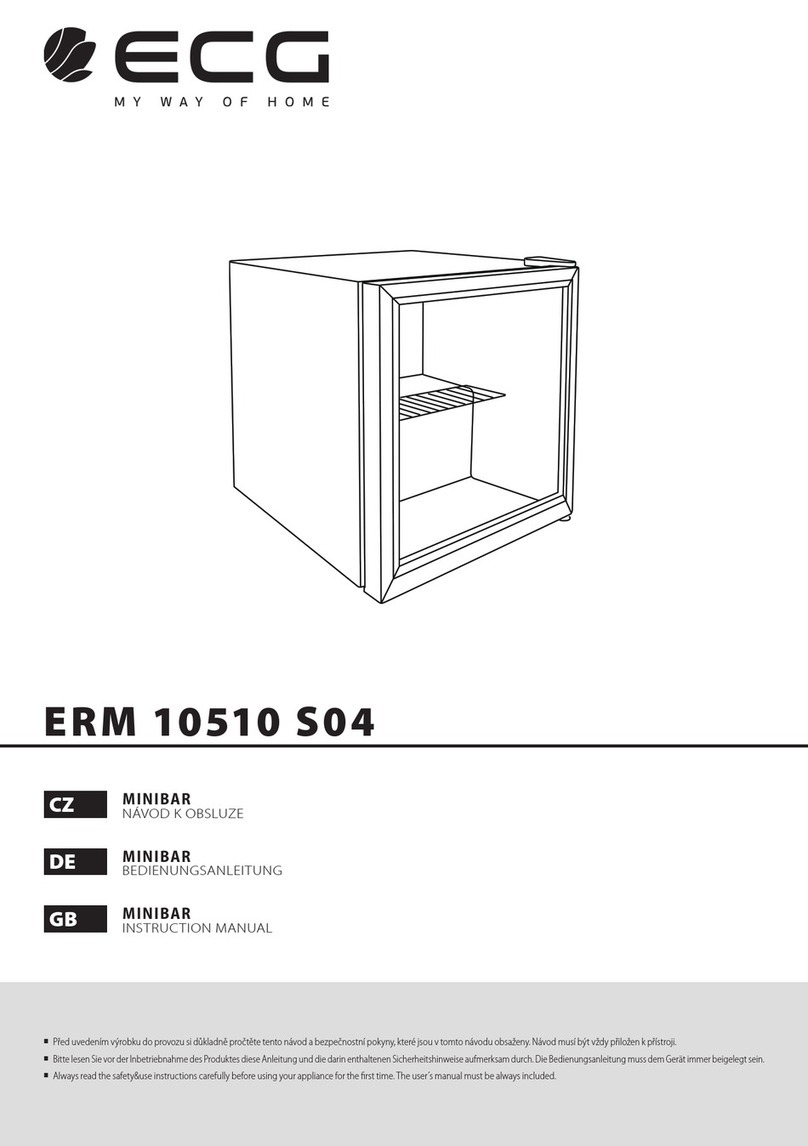
ECG
ECG ERM 10510 S04 User manual

ECG
ECG ERB 21860 NWE User manual
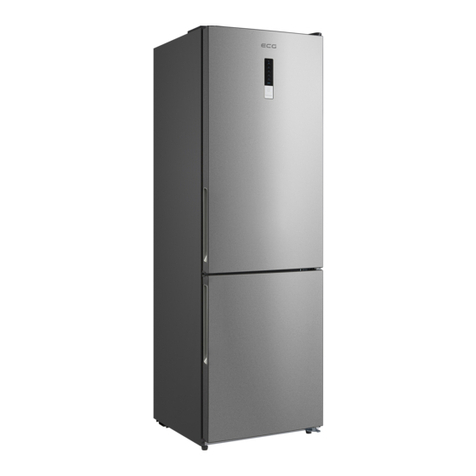
ECG
ECG ERB 21880 NXE User manual

ECG
ECG ERB 21861 NXE User manual

ECG
ECG EFRT 11770 NWE User manual

ECG
ECG ERT 10860 WE User manual

ECG
ECG ERB 21700 WA+ User manual

ECG
ECG ERM 10470 WA+ User manual
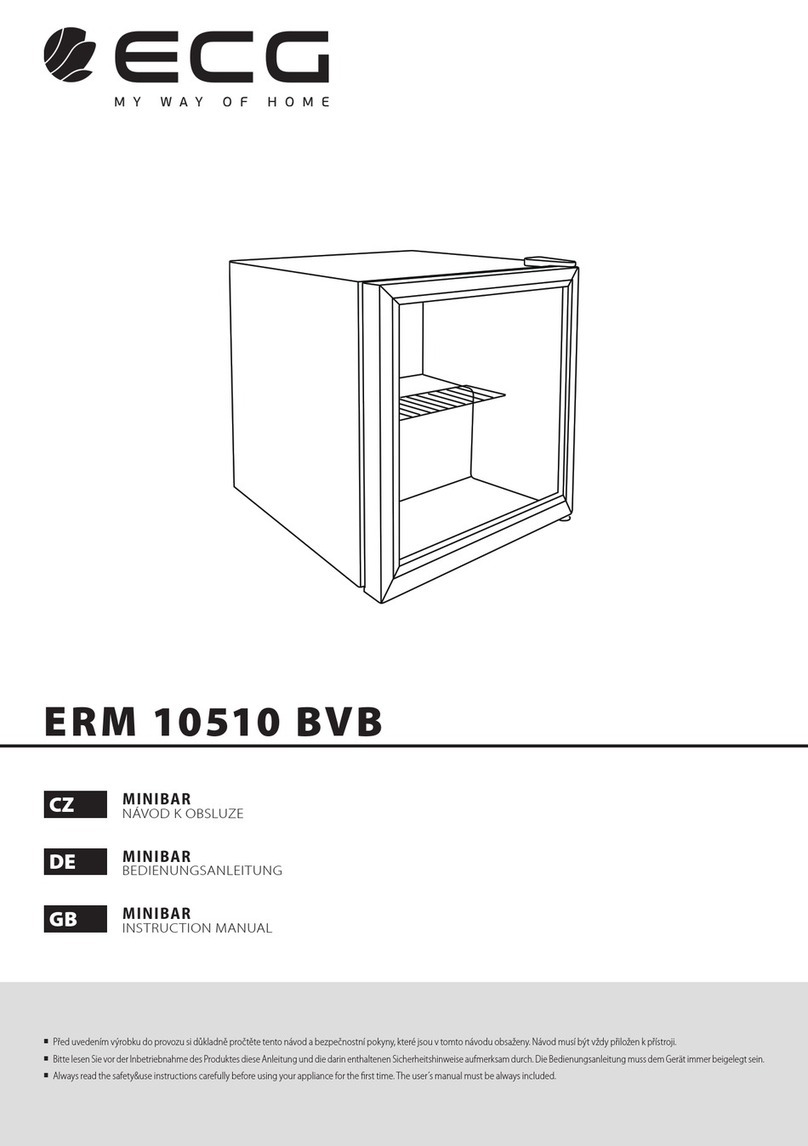
ECG
ECG ERM 10510 BVB User manual

ECG
ECG ERB 21860 NWA++ User manual
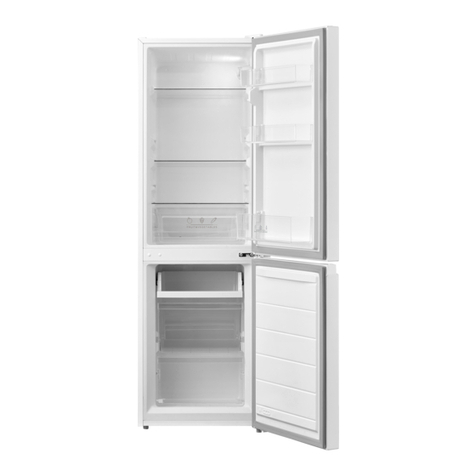
ECG
ECG ERB 21500 WF User manual

ECG
ECG ERM 10471 WA++ User manual

ECG
ECG ERM 10510 BRM User manual
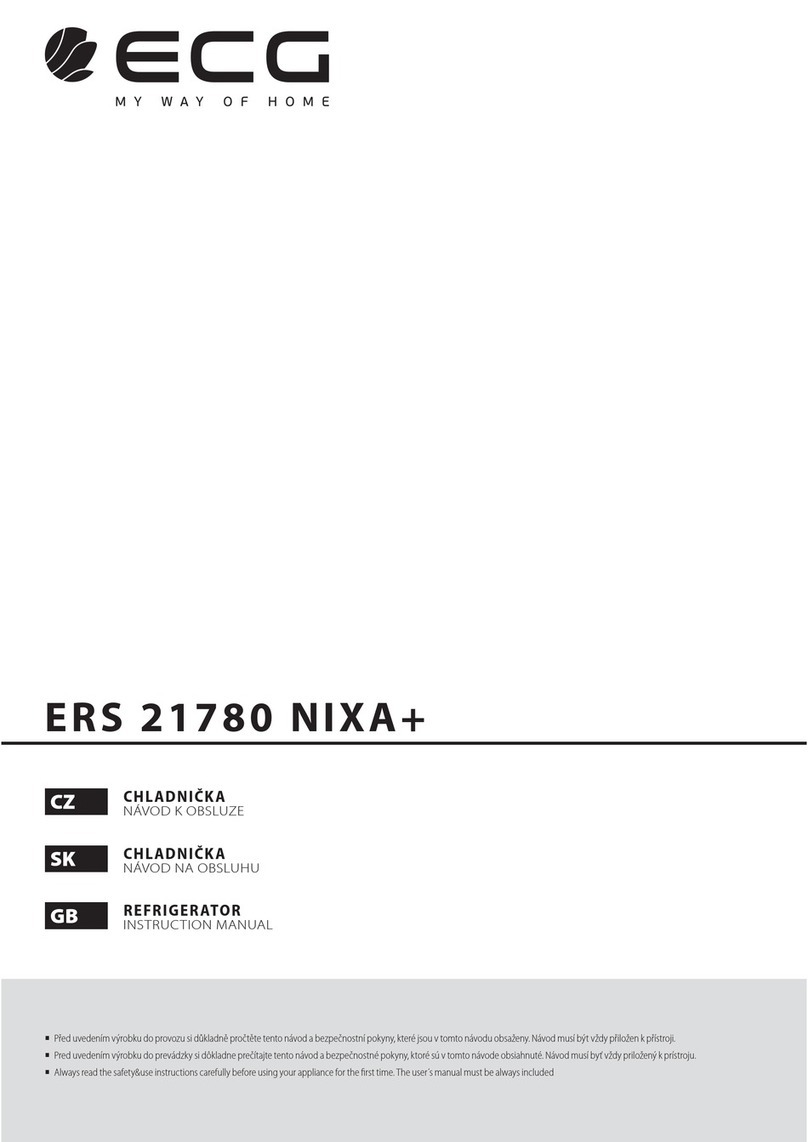
ECG
ECG ERS 21780 NIXA+ User manual
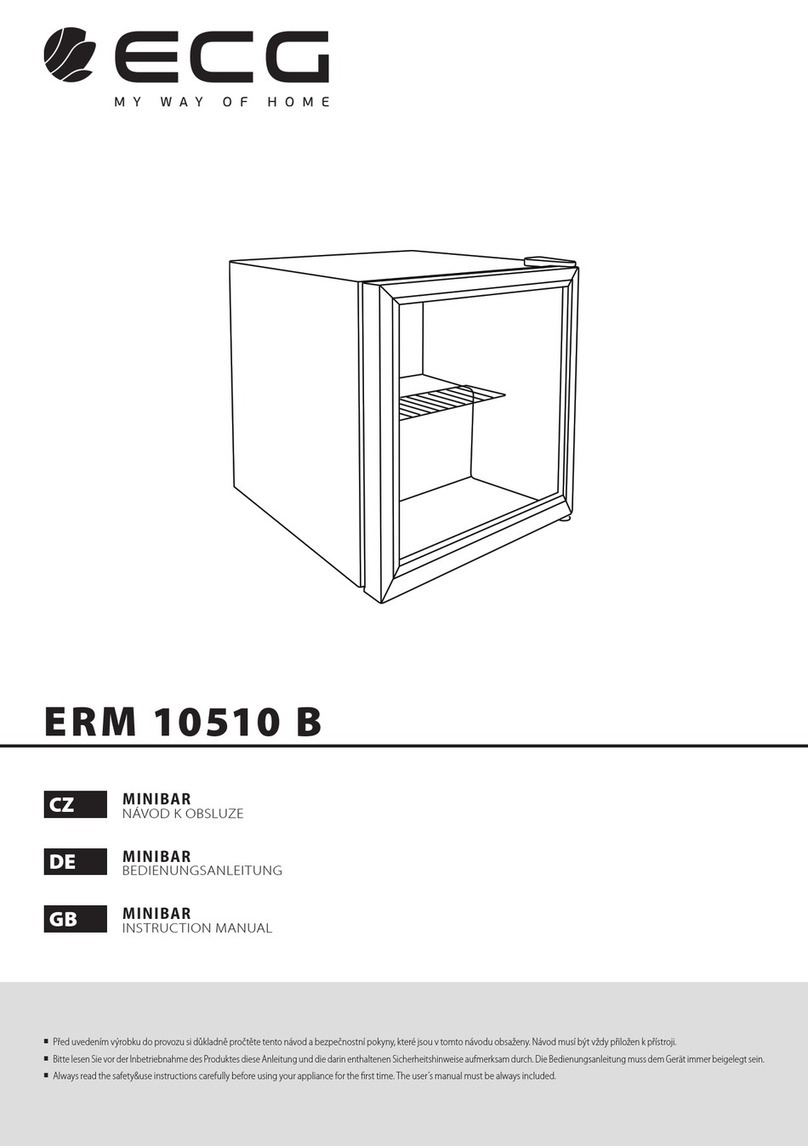
ECG
ECG ERM 10510 B User manual
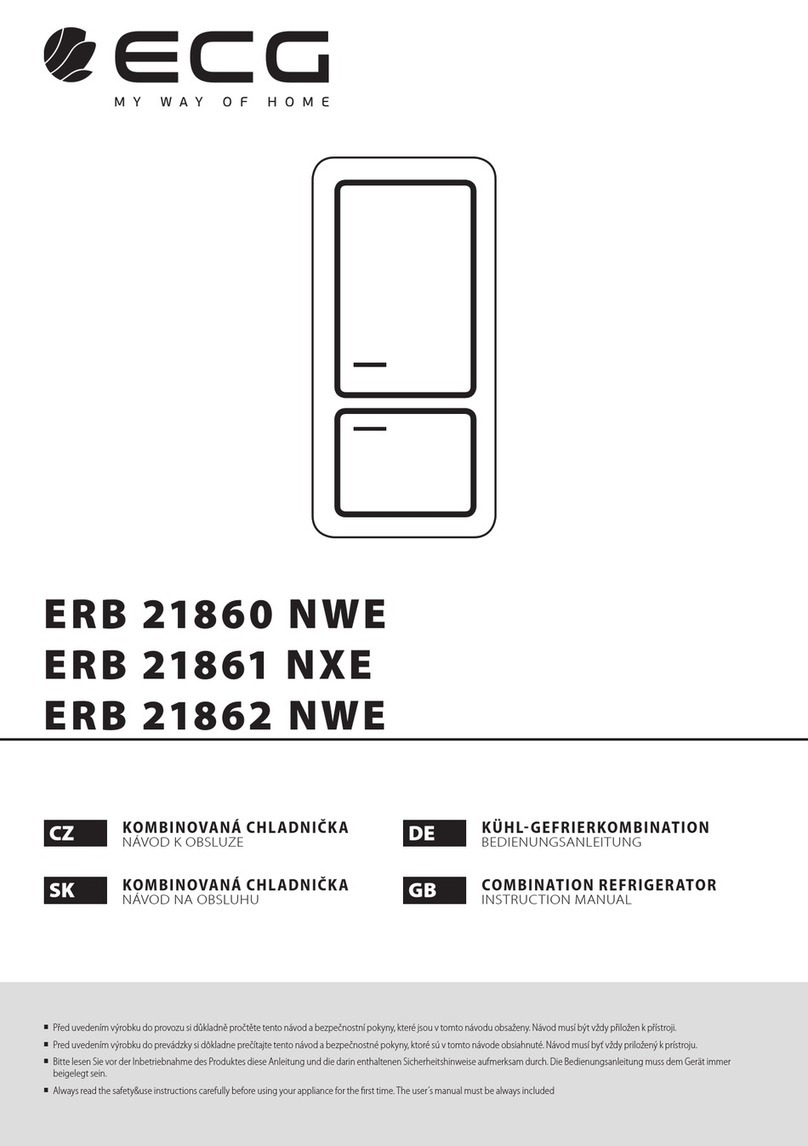
ECG
ECG ERB 21862 NWE User manual

ECG
ECG ERS 21780 NWA+ User manual

ECG
ECG ERB 21420 W User manual
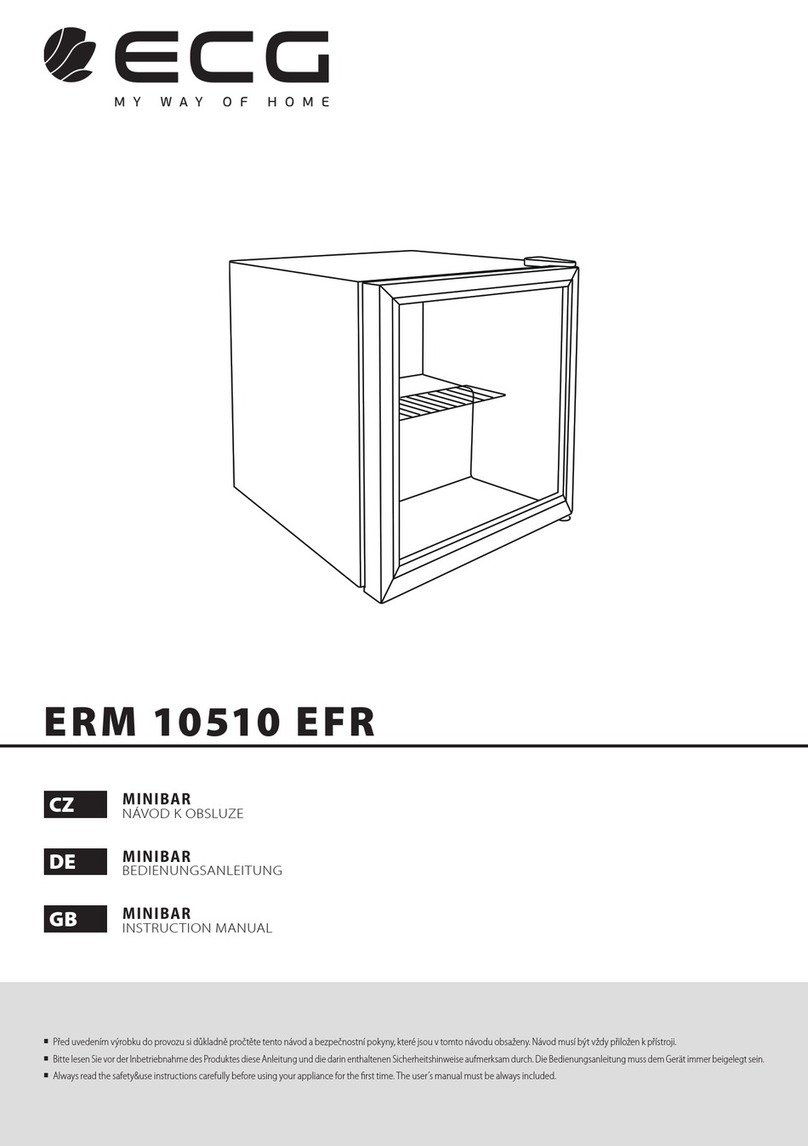
ECG
ECG ERM 10510 EFR User manual
